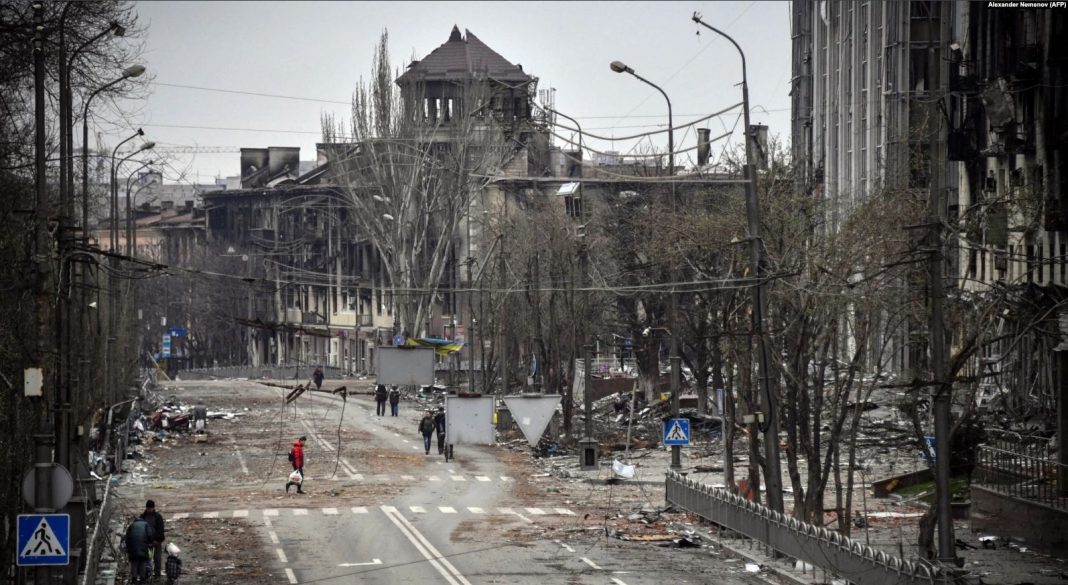As of August 20, 2022, the Russian Federation controls about 20% of Ukrainian sovereign territories: the Autonomous Republic of Crimea and the Luhansk region (in full), most of the Kherson, Donetsk and Zaporizhzhia regions, and partially – the Kharkiv and Mykolaiv regions. Ukraine lost access to the Sea of Azov, control over the land route to Crimea and the mouth of the Dnieper. Communication with the Black Sea (except for specifically agreed options for the supply of grain to Turkey) is also problematized. The Ukrainian economy also suffered losses: metallurgical, machine-building, shipbuilding, coal, and agricultural enterprises were lost, and the number of sown areas in Ukraine in 2022 decreased by 23%. Although in his televised address on February 24, 2022, Vladimir Putin stated that the occupation of Ukrainian lands is not included in the plans of the Russian Federation.
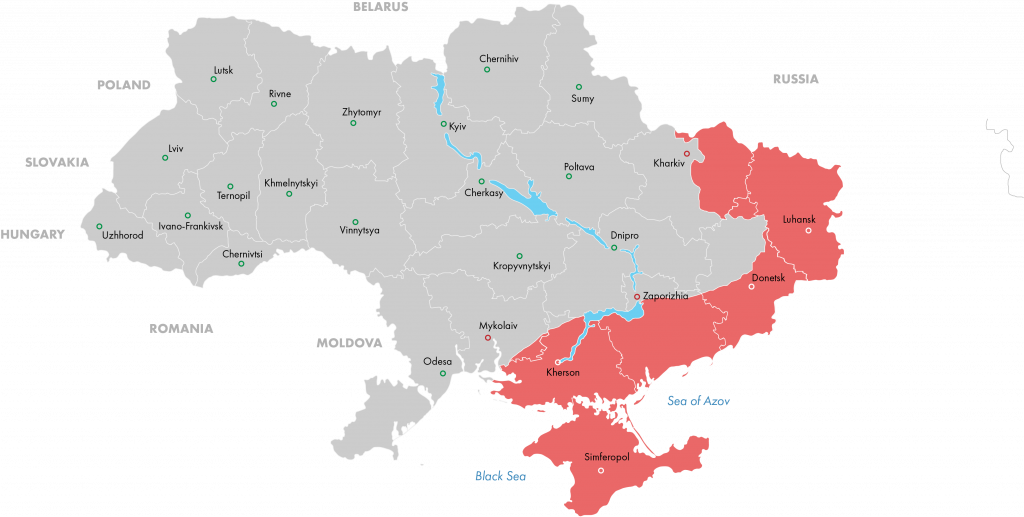
In the occupied territories, the Russian Federation established the so-called “temporary military-civilian administrations.” In this respect, the question legitimately arises about the nature of collaborationism in the occupied Ukrainian territories.
Being a native of Zaporizhia, Vladimir Rogov, who was living in Moscow since 2014, proclaimed himself as “a member of the military-civilian administration of the Zaporizhzhia region.” It was announced that “Cossack squads”, led by a native of Kyiv, Alexei Selivanov, who until 2014 worked in the Ministry of Defense of Ukraine appeared in the Zaporizhzhia region.
In Melitopol, Zaporizhzhia region, the Russian military established their local authority headed by the former MP Yevgeny Balitsky, deputies of the Melitopol city council Alexander Falko and Galina Danilchenko (who formally headed the city’s “committee of people’s deputies”). Local residents also suspect that the new collaborationist authorities in the city, especially local deputies from the pro-Russian Opposition Block party, may be involved in the kidnappings of representatives of the Ukrainian authorities and activists. According to local residents, this party usurped authority in the city: “Acting mayor, his deputies, even some housing and communal services, in particular, the water utility, are already under the authority of representatives of the Opposition Block. It was also stated that the owner of the local TV channel, a Melitopol deputy from the Opposition Block, voluntarily gave its frequencies to the broadcasting of Russian TV.
Analyzing the information space, we can assume that today there is a confrontation between Balitsky and Rogov for the right to be “the head of the Zaporizhzhia region.”
In Energodar, Zaporizhia region, a parallel institution of power was created, headed by the deputy of the city council Andriy Shevchik – “the public council of the city’s self-organization”. In Berdyansk, Zaporizhzhia region, Alexander Saulenko took over as the “acting head of the city”. A criminal case was initiated against the head of the Mikhailovsky community of the Zaporizhzhia region, Vladimir Rykun, who said that he had entered into negotiations with the Russian military.
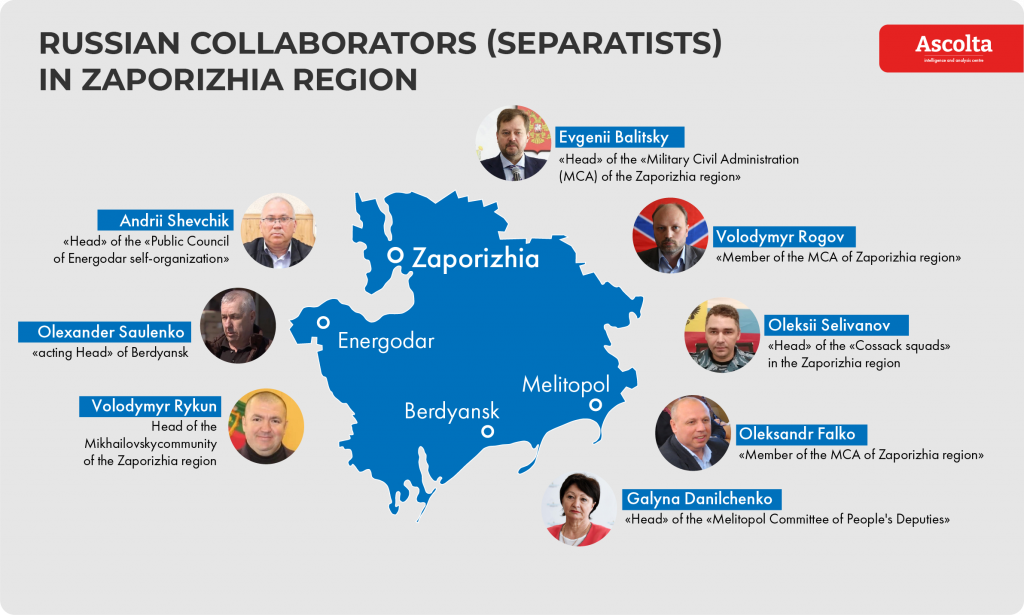
The mayor of Kupyansk (Kharkiv region) Gennady Matsegora, went over to the side of Russia; later, he recorded a video message to Ukrainian President Volodymyr Zelensky about the kidnapping of his daughter by SBU officers and asked to release her. The head of Balakleya Ivan Stolbovoy went to cooperate with the Russian authorities. On February 28, 2022, Alexander Bryukhanov, the mayor of the Southern Kharkiv region, was detained on suspicion of high treason.
According to reports, the Russian authorities are preparing Dmytro Svyatash to become the head of the Kharkiv region. Earlier he was an MP and one of the most influential Ukrainian entrepreneurs (in 2000-2010 he possessed 10% of the Ukrainian car market). After being accused of embezzling UAH 1 bln, he escaped to Russia. On August 17, it became known that the former mayor of Krasnodar Andrey Alekseenko could be appointed temporary “governor” of the occupied part of the Kharkiv region, against whom a criminal case was initiated in December 2021 on suspicion of taking a bribe on an especially large scale.
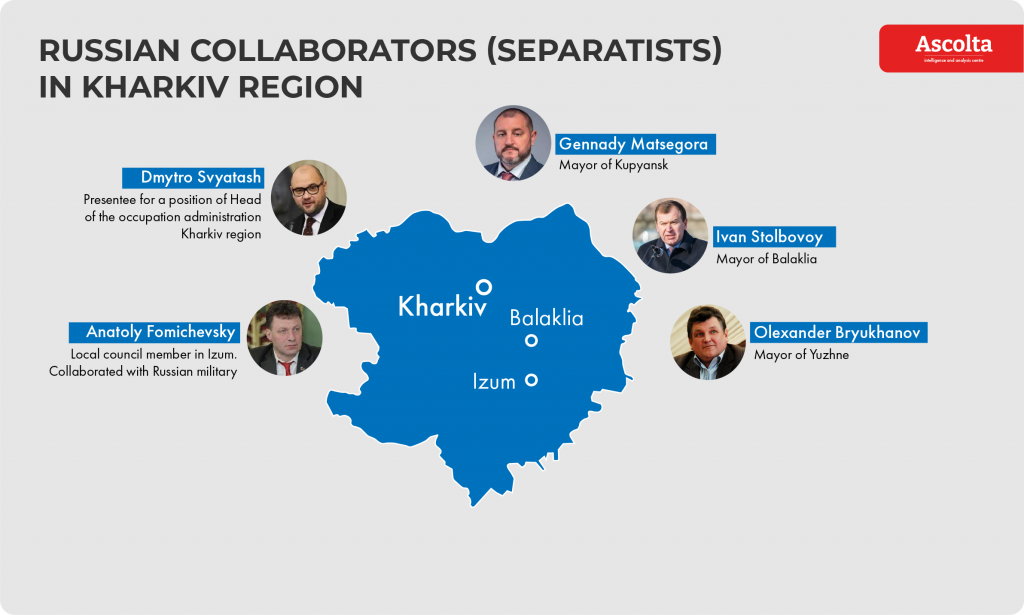
On March 29, Maxim Strelnik, an official of the Izyum city council, stated that Anatoly Fomichevsky, an “Opposition Platform For Life” city council deputy, revealed the unprotected road to Russian troops using which they entered the city.
In the Luhansk region, the Russian military was supported by Albert Zinchenko, head of Stanytsia Luhanska village, Sergey Hortiv, head of Rubizhne, Igor Dzyuba, head of the Markov community, Oleg Savchenko, head of Melovoye village, and Lyudmila Rusanova, head of the Svatovsky district council.
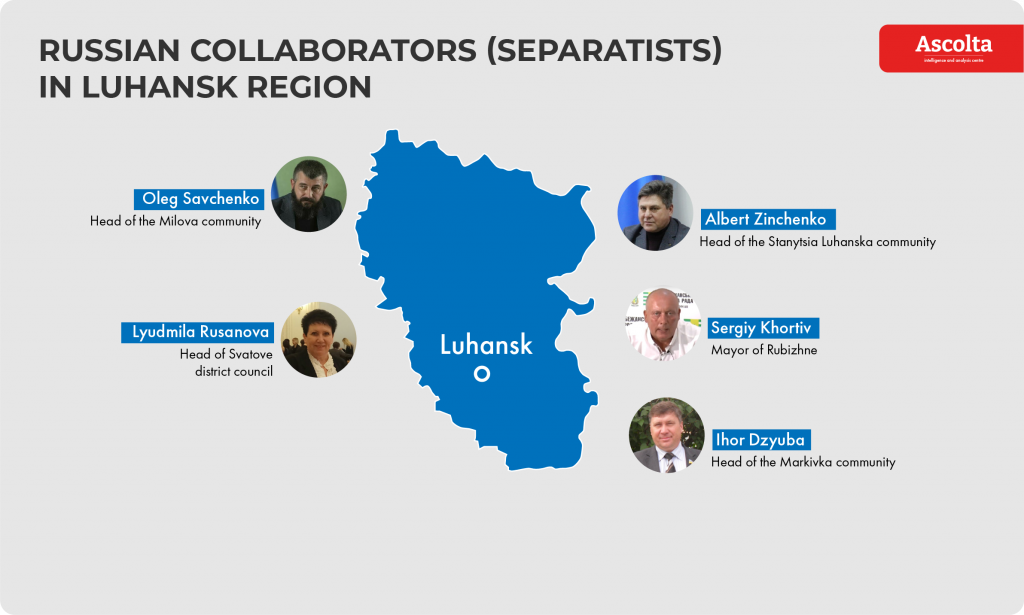
In Kakhovka, Kherson region, the Russian military captured the building of the city council and appointed Pavel Filipchuk (until 2020 – a deputy of the Kherson Regional Council from the Opposition Block) as the “head” of the city, and Oleg Bukhovets (a former deputy of the Kakhovka district council from the “Party of Regions” (2010-2015)) as the “head” of the so-called “police”. In Genichesk Andriy Klochko, deputy of the Genichesk District Council from the Opposition Platform for Life was appointed as “acting head of the city”.
In the Kherson region, the local “authority” was headed by a former deputy from the Party of Regions and the former mayor of the city Vladimir Saldo (a significant and influential person), and Kirill Stremousov, a pro-Russian activist and leader of the Kherson Anti-Maidan, became his deputy.
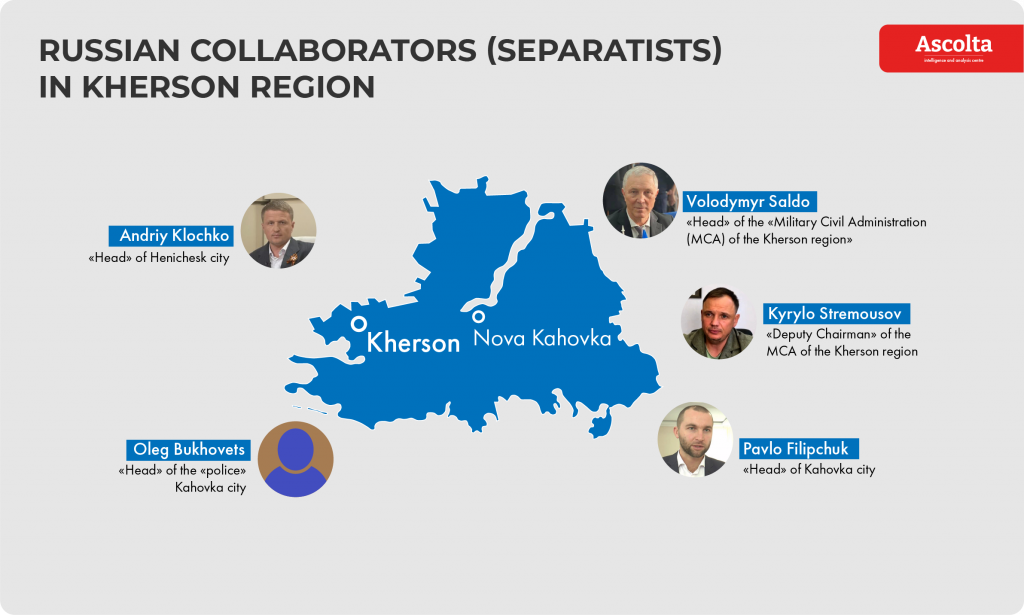
In Mariupol, Donetsk region, Konstantin Ivashchenko, a deputy of the city council from the Opposition Platform – For Life party, proceeded to collaborate with the military of Russia and the “DPR”.
Denis Pushilin and Leonid Pasechnik retain their positions in the leadership of the self-proclaimed DPR and LPR. However, with the outbreak of the military conflict, Russia completely took control of the economic activities of the “republics”, turning Pushilin and Pasechnik into political “wedding generals”.
The Russian leadership is showing a high level of interest in the occupied territories. So, during May-July, the territory was visited by the First Deputy Head of the Presidential Administration of the Russian Federation Sergey Kiriyenko three times (during one of them, the cortege came under fire from the artillery of the Armed Forces of Ukraine), and the First Deputy Head of the Federation Council Andrey Turchak (Kiriyenko’s political rival), and on August 11 several politics arrived in Lugansk, including Dmitry Medvedev, First Deputy Head of the Security Council of the Russian Federation, and heads of law enforcement agencies. The main topic discussed during the visit was the harmonization of the legislation of the self-proclaimed republics with the legislation of the Russian Federation.
Previously, on September 11, it was planned to hold a referendum on joining Russia in the Donbas and other occupied territories. However, to date, this issue has been postponed: firstly, to preserve the possibility of bargaining with Ukraine if the Ukrainian side agrees to negotiations, and secondly, based on the understanding that holding a referendum in territories that are not fully controlled is nonsense. Thus, the question of the referendum remains open.
According to unconfirmed reports, the issue of holding referendums will be postponed to the second half of September and will be seen as another step in an attempt to raise the stakes in the negotiation process. Some sources say that such an option is now being actively discussed at the highest level.
During the meeting of the Presidents of Turkey and Ukraine in Lviv on August 18 (with the participation of the UN Secretary-General), Recep Erdoğan conveyed to Vladimir Zelensky the proposals of the Russian side regarding the further settlement of the conflict. These proposals contained the following clauses:
1. Ukraine recognizes Crimea as a part of Russia, the Verkhovna Rada recognizes this and introduces it as an amendment to the Constitution.
2. The concept of an aggressor country is removed from all military doctrines of Ukraine and a neutral agreement on comprehensive cooperation must be concluded and ratified by the parliaments of both countries.
3. LPR and DPR are recognized as separate republics; their sovereignty is approved by all UN member states.
4. Kherson and Zaporizhzhia regions are holding a plebiscite under the auspices of the UN.
5. Ukraine receives a neutral non-bloc status and security guarantees that all UN member states give.
6. Complete demilitarization of Ukraine.
7. For the period of all reforms and implementation of all agreements, an international UN contingent is introduced into the territory of Ukraine to protect the border, nuclear power plants, ports and airports.
8. Snap elections to the Verkhovna Rada.
9. Snap presidential elections.
10. A complete change in the Ukrainian Constitution of Ukraine and its transparency as well as equality for Russian speakers and neutrality.
As expected, Volodymyr Zelenskyy refused: the meeting lasted only 40 minutes, immediately after the meeting, the territories of Crimea and the Belgorod region were shelled, which the Ukrainian side was accused of. However, these proposals show the main goal of Russia: its readiness to give up the conquered territories outside Crimea and Donbas – if Ukraine recognizes Crimea as part of Russia, and the “DPR” and “LPR” as independent countries. The holding of an independent plebiscite under the auspices of the UN in the Zaporizhzhia and Kherson regions will certainly show the desire of the inhabitants of these regions to return to Ukraine (here, pro-Russian sentiments are not as pronounced as in the Donbas, and a significant part of the regions are inhabited by people from Western Ukrainian lands resettled after World War II from territories ceded to Poland).
Russia does not even raise the topic of Kharkiv and the Kharkiv region, de facto recognizing its Ukrainian status (today Russia controls about a quarter of its territory).
The position of the Ukrainian side remains unchanged: no territorial concessions, a continuation of the war until the territorial integrity of the country is restored within the framework defined by the 1996 Constitution.
More than ambiguous is the Ukrainian attempt to continue a forced evacuation of the civilian population from the Donetsk region (and, possibly, from the Zaporizhia and Mykolaiv regions), as has already been stated by the Prime Minister of Ukraine Denys Shmyhal and the Minister for the Reintegration of the Temporarily Occupied Territories Irina Vereshchuk. Officially, it is believed that the reason for the resettlement is the lack of conditions for gas supplies to settlements during the winter heating season (as a concern for people).
Critics of this explanation of the authorities’ actions say that forced displacement in such a situation is nonsense, a person has the right to decide for himself whether he can provide himself with warmth and food (including at the expense of potbelly stoves). Representatives of the DTEK corporation (part of Rinat Akhmetov’s group) said they were ready to compensate for the lack of gas by increasing coal supplies to the region, but the government rejected DTEK’s proposals without explanation, verbally advising “to stay out of your own business.”
To date, we are talking about the forced resettlement of about 300 thousand people remaining in the agglomeration Kramatorsk – Slovyansk – Bakhmut – Avdiivka – Kostyanyinivka – Druzhkivka (these cities remain under the control of the Ukrainian authorities). The problem is that the authorities cannot provide these people with work, housing and material support (the allocated UAH 6,500 per month, which is approximately EUR 150 at the current exchange rate, is clearly an insufficient amount, especially in the context of galloping inflation and rising prices for consumer goods).
As the experience of several evacuation trains from the Donbas has shown, people are in no hurry to leave their homes, only a few citizens gather for evacuation, and the forced evacuation campaign is boycotted.
Meanwhile, the population in the non-governmental controlled territories face another problem: the forced mobilization of men into the “army” of the “DPR” and “LPR”. On the territory of the Lugansk People’s Republic, systematic roundups are organized on men of military age. According to reports from the LPR, there is no one to work in the “republic”, all loaders in stores, and all representatives of professions recognized as non-critical for the economy of the “republic” have been mobilized. The male population hides or tries to escape to Russia or even to the territory of Ukraine (where they are mobilized in the same way and sent to fight – but against the “LPR” and “DPR”). Thus, the situation in the self-proclaimed republics threatens mass depopulation of the population, extinction and depression of the region.
The biggest problem for the occupied territories is the problem of the Zaporizhzhia NPP, the largest nuclear power plant in Europe. Six power units of the station carry a potential threat since the fighting is carried out directly near the reactors. The station is located in the Zaporizhzhia region, about 100 km from Zaporizhzhia, on the left bank of the Dnipro river. On the right bank, there is a large industrial centre of the Dnepropetrovsk region, the city of Nikopol, just opposite the station. The Ukrainian and Russian authorities constantly arrange artillery duels: the Russian side shells Nikopol, and the Ukrainian side hits Energodar, hitting targets in the immediate vicinity of nuclear reactors.
The situation related to the complication of the trip of the Director General of the International Atomic Energy Agency (IAEA) Rafael Grossi to the zone of the Zaporizhzhya nuclear power plant looks odd. In April 2022, he easily visited the Chornobyl NPP. However, after Mr Grossi made a statement about the possible presence of a large amount of enriched uranium on the territory of the Zaporizhzhia NPP, he was accused in the Ukrainian media of working for Russia Westinghouse in October last year; the Russian side claims that this uranium could become the basis for Ukraine to create its own nuclear weapons). After the meeting of the UN Security Council on August 11, 2022, the Ukrainian side allowed the inspection trip of Mr Grossi to Energodar but set several conditions (in particular, a ceasefire during the inspection, entry into the territory exclusively from Ukraine, etc.)
It is clear that the Zaporizhzhia nuclear power plant remains the primary source of environmental danger in the occupied territory. It should also be pointed out that on the territory of the Donetsk and Luhansk regions there are several other sources of environmental danger, in particular, the Yunkom mine in the city of Yuzhnokommunarovsk near Yenakiieve, where on September 16, 1979, an underground controlled nuclear explosion was carried out at a depth of 903 meters. On April 4, 2018, representatives of the self-proclaimed “DPR” announced the cessation of pumping water from the Yunkom mine due to a lack of funds in the budget. According to some experts, this will lead to flooding and release of radioactive groundwater to the surface.
The Russian side “inspected” the Zaporizhzhia NPP several times and warned Ukraine that if the shelling will be continued, it will result in disconnecting Ukraine from the NPP and transferring it to the balance of Rosatom.
An important moment of the new reality in the occupied territories is the activity of resistance groups, popularly called “partisan detachments”. In the Zaporizhzhia and Kherson regions, information is systematically published in the form of leaflets and graffiti with anti-Russian content. The raids of the Russian special services give a minimal result since during the occupation only 6-8 sabotage groups were recorded, the activity of which is increasing.
Also in the occupied territories, the tactics of individual terror are used against representatives of the occupying authorities. On May 30, 2022, a car belonging to the self-proclaimed governor Yevgeny Balitsky was blown up in Melitopol.
According to preliminary data, Balitsky’s niece Evgenia Zaitseva suffered. On June 25, one of the most prominent collaborators Dmitry Savluchenko was blown up in Kherson.
On July 11, an attempt on the life of the “head of administration” Vladimir Saldo was prevented in Kherson – a bomb was planted along the route of his car. On August 5, Saldo was poisoned by an unknown drug – in an unconscious state, he was taken to Crimea, and from there to Moscow, he was barely saved. Less fortunate was Saldo’s deputy Vitaly Gura: as a result of poisoning with the same substance, Gura died on August 6.
On August 20, an attempt was made on the life of Konstantin Ivashchenko, the “mayor” of Mariupol. The assassination attempt took place near the city zoo: an explosive device went off in the way of Ivashchenko’s car.
Despite the increasing frequency of such acts against the occupying authorities, as our own sources testify, there is a huge number of people in Moscow willing to come for work in the Kherson and Zaporizhzhia regions, as well as in the Donbas. The expectation is that, firstly, these regions are considered as “springboards” for a career, and provide an opportunity to show and prove themselves. Secondly, many understand that the restoration and recovery of the region’s economy will require large investments and capital investment, so they are counting on banal profit.
Local citizens must often act in the ranks of fire spotters – in particular, ensuring the accuracy of aiming missiles at infrastructure and military facilities. Also, a significant part of the population of the occupied regions continues to maintain a loyal attitude towards the Ukrainian authorities and consider the occupation to be temporary. The fact of mass resistance of the local population is also recognized by the Russian occupation authorities.
At the same time, the occupying authorities are trying to introduce Russian school programs in schools, carry out appropriate work among teachers and import Russian school textbooks into the occupied regions. Books in the Ukrainian language are massively withdrawn from libraries and destroyed – especially history, some literary works, and books about politics. In the Kherson and Zaporizhzhia regions, the broadcasting of Russian television channels and radio stations has been restored, and restrictions are being introduced on the use of several Internet resources (with clearly pro-Ukrainian content).
Information is constantly coming in about kidnappings and bullying of persons representing the Ukrainian authorities (deputies of local councils, representatives of the executive branch) to force them to go over to the side of the occupiers. Also, kidnappings and long-term detention of family members of pro-Ukrainian public figures have become a frequent occurrence. So in Nova Kakhovka, Kherson region, representatives of the occupying “authority” kidnapped the directors of lyceums No. 3 and No. 2 of the Novokakhovka City Council, Irina Dubas and Oksana Yakubova. At the same time, the proven facts of murders by representatives of law enforcement agencies of pro-Ukrainian citizens have not been recorded.
There is a certain connection between the occupied and Kyiv-controlled regions. There is a permanent corridor for citizens to cross the front line. Until recently, Russian and Ukrainian checkpoints allowed special Ukrposhta cash-in-transit vehicles to deliver money to pensioners into the occupied territory without hindrance. Not a single case of robbery of cars of collectors was documented.
A serious situation has grown with enterprises operating in the occupied territory. The Russian authorities have set a deadline until September 15, by which the former owners of enterprises and business facilities can re-register ownership based on Russian regulation. After that, the enterprises will be nationalized and get new owners. Representatives of big businesses mostly ignored the proposal, realizing that by agreeing to such conditions they would not be able to find an opportunity for free lending to businesses. Medium-sized businesses try to resolve issues through “shim firms” or through nominees.
The self-proclaimed “chairman of the regional government” of the Kherson region, Sergey Eliseev, stated: “The government (note: occupying!) of the Kherson region decided and determined the procedure for recognizing several enterprises as ownerless, transferring them to the balance sheet of the state property fund of the Kherson region, with the following transfer to external management by those who wish who will want to manage these assets and whom we deem worthy to manage these enterprises. The owners certainly have the opportunity to retain their right to the enterprise. There is an inviolable prerequisite here – they must re-register with the tax office without fail, obtain registration, and open bank accounts. They should be clear and transparent to us. And let them work, no one interferes.” Obviously, corruption schemes have appeared to ensure that the new rules are circumvented for bribes or that representatives of the new occupation administration enter into a share in the business of those who do not want to re-register their enterprises.
At the same time, the Russian authorities declare their desire to invest in the restoration of Donbas economy. In mid-July, Marat Khusnullin, Deputy Prime Minister of the Russian government, visited Donetsk, Luhansk and Mariupol. After the trip, he reported to Vladimir Putin on the actions and projects taken to restore Donbas.
Putin set the task to Khusnullin that the residents of Donbas have to spend the winter “in normal, human conditions.” Putin agreed with Khusnullin’s idea of issuing housing certificates to those living in the Donbas. Residents will be entitled to receive RUR 6000 (less than EUR 100) per sq m for renovation. Putin also instructed to build a multidisciplinary medical centre in Mariupol and a new perinatal centre in Donetsk “within a couple of years”. Khusnullin declared the possibility of retaining some of the jobs at Azovstal without restoring hazardous production. Most of the enterprises (and even partially Azovstal) are scheduling to be restored. In Mariupol, it was decided to build and put into operation new residential micro districts by October to partly solve the issue of accommodation for citizens. Social infrastructure facilities are also being restored, for example, the Mariupol Drama Theatre.
According to Khusnullin’s statements, Chinese and Northern Korean construction firms and organizations will be involved in the restoration of destroyed Donbas cities. 26,000 builders are currently working in the occupied Ukrainian territories, but additional forces are needed.
Things in the social sphere of the Kherson region are much worse than in the Donbas. Firstly, Kherson experienced a serious depopulation currently having about 40% of the pre-war population. Secondly, there is a big problem with working enterprises. The city and the region require subsidies. On August 11, Ekaterina Gubareva, the deputy “head of the regional administration” announced that the socio-economic situation in the Kherson region becomes steady. “We can talk about stabilization. If earlier social support to the population was made in manual mode through one-time payments of RUR 10 000, now it is being monthly and systematically.” She said that a budget application for the Kherson region for RUR 6 bln was formed for August. “This is twice as much as in July. We finance pensions and other social benefits in full,” Gubareva explained.
At the same time, information coming from the region shows that there is a problem with food, and a shortage of essential goods. The International Committee of the Red Cross has access to all the occupied territories and is trying to meet the needs of citizens for medicines and humanitarian aid.
It is also important to note that two currencies continue to circulate in the occupied territories: the Russian ruble and the Ukrainian hryvnia, while local “authorities” believe that this situation may persist for several years.

